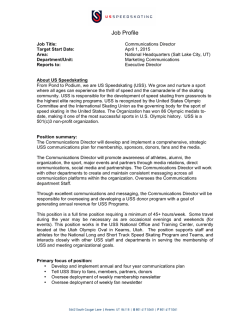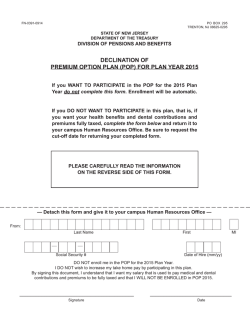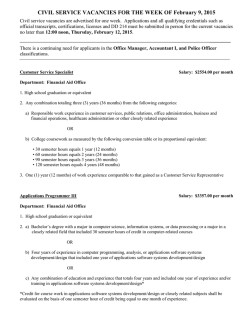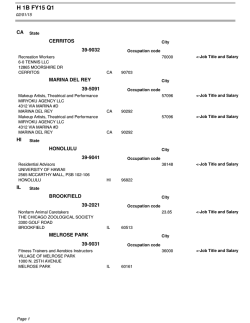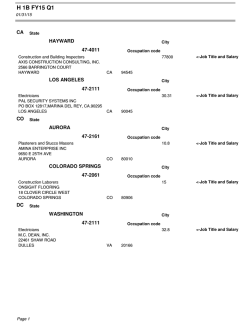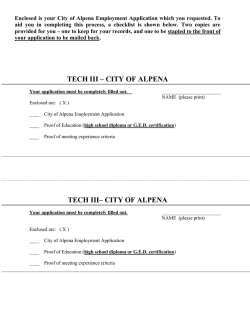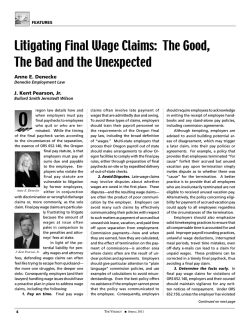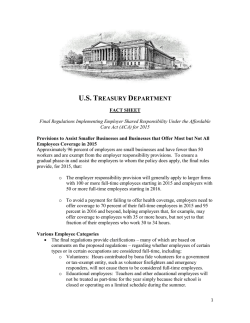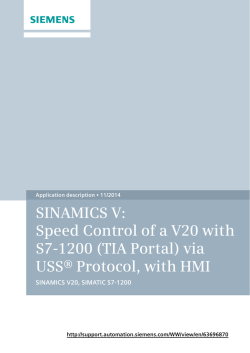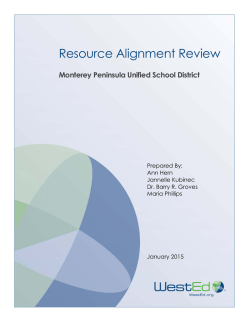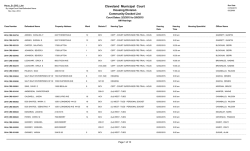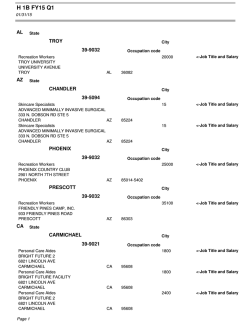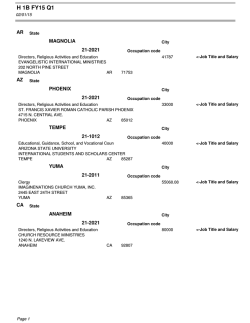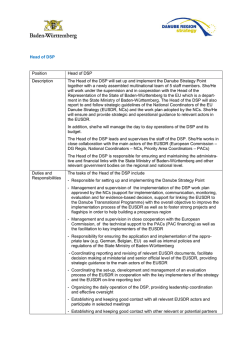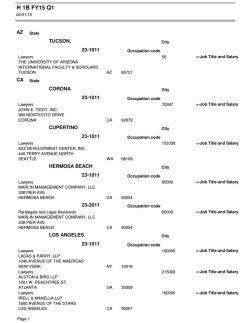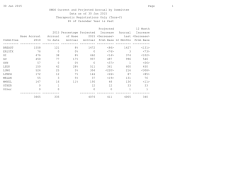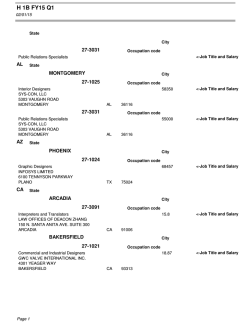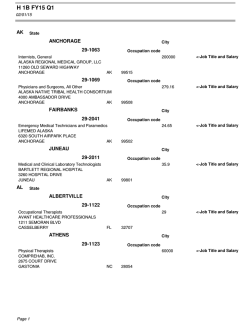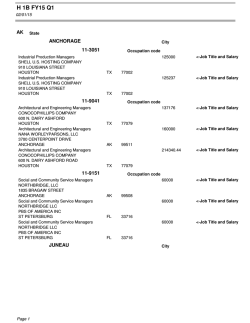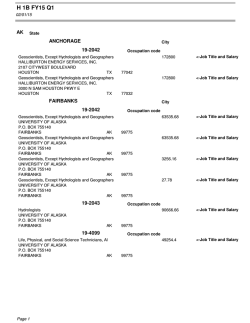
a summary for members, 29 Jan 2015
The Joint Negotiating Committee (JNC) proposal for reform of the USS - A Summary for USS Members, 29th January 2015 This reform proposal seeks to ensure that the USS can continue to be an attractive and affordable pension scheme for all members, both current and future. During more than a year of discussions on reform of USS, a range of possible options has been considered, modelled and costed. Advice and views were sought by the JNC from USS, the Pensions Regulator, member representatives (through the University & College Union), employers (through Universities UK), actuaries and pensions experts. The proposal was also put to UCU members through a consultative ballot which resulted in 67% voting in favour of the proposal. The reforms proposed are designed both to address the substantial deficit in the USS scheme funding and to mitigate the risk that contribution rates will become unaffordable for both employees and employers. The JNC proposal outlined below aims to offer the best possible deal for employees within the constraints that the USS Trustee has set, and the requirements of the Pensions Regulator. The proposal retains a defined benefit (DB) structure, with an improved accrual rate, for the highest proportion of members possible, while remaining just within the affordability constraints identified by the Trustee. The proposal is also subject to consideration by the USS Trustee Board and the Pensions Regulator. There will then be a formal consultation on these proposed changes undertaken by USS employers with all eligible employees which will start in March. This will allow all affected employees to review and comment on the proposed changes. As a result of the consultation there could be some further changes to this proposal before a final decision is taken by the USS Trustee in summer 2015. Why is reform necessary? The USS is no longer affordable in its current form. The USS Trustee is legally responsible for making sure that there is enough money in the fund to pay members’ benefits, both past and future. Currently there is a substantial shortfall, or deficit, between the value of the benefits already built up and the value of the fund’s assets that are due to pay for these benefits. As well as being sizeable, the deficit is volatile and this volatility poses additional risks to the security of the USS and the HE sector employers. 1 The USS is a private occupational pension scheme and as such falls under the remit of the Pensions Regulator. It has to meet certain minimum levels of funding; the indicative results of the most recent triennial valuation in March 2014 show that the scheme deficit was £13 billion. Accordingly, the USS Trustee Board is required to produce a recovery plan in order to address this substantial scheme deficit over a reasonable period and the plan has to be submitted to the Pensions Regulator. If no reforms are made, the USS Trustee Board will be compelled to impose increased contributions to a level that would be unsustainable for members (at around 12%) and employers (at around 25%) alike. A summary1 of the JNC proposal for reform of the USS - 29th January 2015 The proposed implementation date of the proposed benefit reforms is 1 April 2016. Final salary accruals would cease as at 31 March 2016. Benefits built up before this date would be protected. Their value would be calculated using the existing definition of pensionable salary and service as at 31 March 2016 and from that date accrued benefits would be increased annually in line with CPI, rather than increases in final salary. All members would build up future defined benefits in the Career Revalued Benefits (CRB) section based on an accrual rate of 1/75th of actual pensionable salary. The right to a tax free cash sum of 3 times pension (3/75ths) will also be increased in line with the higher accrual rate. This is higher than the current CRB accrual rate of 1/80th and so offers improved benefits for those currently in the CRB section Benefits in the CRB section would also be increased annually in line with CPI. Benefits in the CRB section would be based on the first £55,000 of the member’s pensionable salary, based on their actual pay, not the full time equivalent. Therefore for members earning up to £55,000 their total salary would be pensioned through the CRB scheme; this is estimated to apply to 83% of all active USS members.However, all members would receive this core benefit up to and including the salary threshold of £55,000. The salary threshold would increase each year in line with CPI (subject to the outcome of a review to be completed by the USS Joint Negotiating Committee by 31 March 2020). 1 This document provides a short summary. The USS scheme rules would be the ultimate reference. Fuller details would be provided as part of the statutory consultation with members. 2 If the member earns more than £55,000 they would still build up CRB benefits on their salary up to the salary threshold of £55,000, but any pensionable salary over this threshold would instead be pensioned through a new Defined Contribution (DC) section of the scheme. Employers would pay a contribution of 12% of pensionable salary over the threshold into the DC section. Employee contributions would increase to 8% of pensionable salary. If the member earns over the £55,000 salary threshold then their contribution of 8% of their pensionable salary over the threshold will be paid into their DC pot, in addition to the employer’s 12% contribution. This provides a substantial total DC contribution of 20% of salary over the £55,000 threshold. All members would have the opportunity to choose to pay in an additional 1% of pensionable salary into their personal DC pot, which would be matched by their employer to build up an additional flexible DC fund. This option would be available to those members earning below the £55,000 salary threshold as well as those earning over this amount. Benefits on death in service and on ill health would remain comparable with current provision in the CRB section of USS. Employers would commit to pay contributions of no less than 18% of payroll for the next two valuations. This extends the increased employer contribution rate until the 2020 valuation (i.e. until 31 March 2020). 18% is a blended rate payable by all employers and includes the contributions to the DB and DC sections of the scheme. If the USS funding position as assessed at triennial valuations were to improve, over and above the improvements in funding assumed in the deficit recovery plan, employers would commit to using this to improve member benefits. There also remain a number of detailed specification points which the employers, UCU and USS and our advisers will discuss further. 3 Summary table Element of benefit design Blended employer contribution 18% payable on total salary DB section on salaries up to £55,000 Salary link for past service Increased annually by CPI2 Future benefit design CRB Pension accrual rate 1/75ths Lump sum accrual rate 3/75ths CRB salary threshold £55,000 Indexation of CRB benefits Annually by CPI2 Increases in salary threshold Annually by CPI2 Employee contribution 8% Matched DC contributions Voluntary 1% from employee matched by employer DC section on salaries above £55,000 Employee contribution 8% on salary above the threshold of £55,000 Employer contribution 12% of salary above the threshold of £55,000 Matched contributions Voluntary 1% from employee matched by employer Important information about the legal status of this document This document has been prepared at the date given for illustrative purposes only, using a range of assumptions which are available on request. As such, it should not be used or relied upon by any person for any other purpose and all third parties are hereby notified the document shall not be used as a substitute for any enquiries, procedures or advice which ought to be undertaken or sought by them. This document was based on data available to us as at the date of writing and takes no account of developments after that date. With respect to data/information on which we have relied in producing the document (including that from third parties), it is not possible for us to confirm the accuracy or completeness of such data/information. The information is based on the face value of information provided by or on behalf of third party sources and we have not verified the provenance, validity, completeness or accuracy of such information and give no representations or warranties in respect of such matters. Whilst it is hoped that the JNC proposal will achieve the desired results, neither the USS, Universities UK, the University and College Union, Employers Pensions Forum for Higher Education or their advisers, or the participating employers, can give any assurances as to the future financial status of the scheme and, as a result, whether any further changes will be required to the scheme at some point in the future. 2 CPI increases in line with current USS rules i.e. in full up to 5% then half any further increase to a maximum of 10% 4
© Copyright 2026
